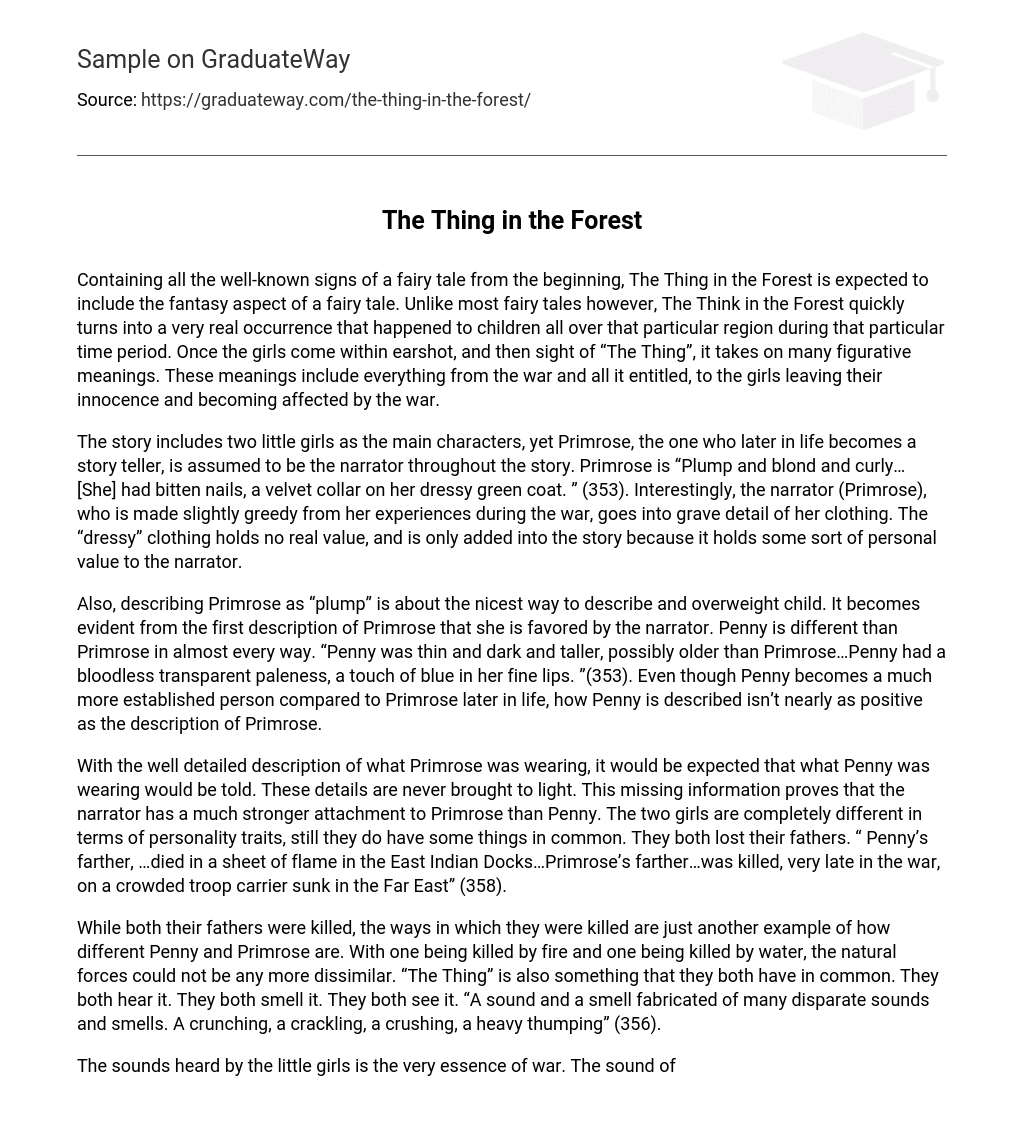The Thing in the Forest, a story that begins like a typical fairy tale, incorporates the elements of fantasy commonly associated with such tales. However, unlike traditional fairy tales, this story evolves into a realistic event that unfolded among children in a specific region and time period. As the girls approach, they both hear and see “The Thing,” which takes on various symbolic interpretations. These interpretations encompass references to the war and its ramifications, as well as the girls’ loss of innocence and the impact of the war on their lives.
The main characters of the story are two little girls, with Primrose being the narrator. She is described as “plump and blond and curly” with bitten nails and a velvet collar on her dressy green coat (353). Despite her experiences during the war making her slightly greedy, Primrose goes into great detail about her clothing. The inclusion of the “dressy” clothing serves no real purpose other than holding personal value for the narrator.
Also, the narrator describes Primrose as “plump,” which is a gentle way of saying she is overweight. From the initial description, it is clear that the narrator has a fondness for Primrose. In contrast, Penny is very different from Primrose. The narrator explains that Penny is thin and dark, possibly older than Primrose. Penny’s fine lips have a pale, almost transparent appearance with a hint of blue. Despite Penny achieving more success later in life compared to Primrose, the description of Penny is not nearly as positive as the description of Primrose.
Although the narrator provides a thorough description of Primrose’s attire, no information is given about what Penny was wearing. This omission suggests that the narrator has a stronger emotional connection to Primrose than Penny. Despite their different personalities, the two girls share a common experience of losing their fathers. Penny’s father died in a fire at the East Indian Docks, while Primrose’s father perished on a troop carrier that was sunk in the Far East towards the end of the war (358).
Both Penny and Primrose have fathers who were killed. However, their fathers’ deaths highlight the stark differences between the two girls. One father perished in a fire while the other met his demise in water, revealing the contrasting nature of the natural forces involved. Another similarity between Penny and Primrose is their encounter with “The Thing.” They can both perceive it through their senses – hearing, smelling, and seeing. The description of “The Thing” encompasses a medley of various sounds and smells, including crunching, crackling, crushing, and heavy thumping (356).
The little girls have experienced firsthand the sounds that embody war – the sounds of troops and machinery destroying everything in their path. These are the same sounds that forced them to be sent away. The description of the face of war is one of pure misery, with a rubbery or fleshy mask covering a shapeless sprouting bulb of a head. It displays neither wrath nor greed, but only sheer despair (357). Gas masks made from rubbery materials were worn by soldiers, representing the face of war. War is not just a source of misery for the military personnel involved, but for everyone. The girls were sent away in order to protect their innocence.
Once they entered the forest, they left behind their innocence and became conscious of the surrounding war. Following their encounter with “The Thing”, the girls became separated and pursued contrasting paths in life. Despite their initial differences, they continued to lead divergent lives. The war affected them in comparable ways; “They both never married.” (358). Penny and Primrose both chose professions that were influenced by the war, but these careers aligned with their individual personalities. Even in the absence of the war, it is likely that they would have both selected careers based on similar criteria.
The war likely changed the fact that neither of them married. War has the ability to unite individuals who would not typically have anything in common. “The Thing” represents all the negative aspects of the war as perceived by two young girls. Although they could not fully comprehend this malevolence, they knew it was present. Additionally, the story forms a circular narrative, beginning and ending with the same tale. The influence of the war on these girls continues to be transmitted through Primrose, the narrator.





